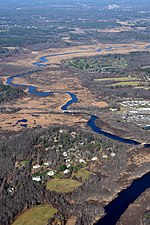Concord Old Block House

Concord Old Block House is a historic First Period house at 57 Lowell Road in Concord, Massachusetts. Some sources allege that part of the home, likely the northern room, is the oldest building in Concord, known as the "Old Block House" which served as a garrison from attacks during King Philip’s War in the 1670s. There are claims that the blockhouse was moved from near Main Street northeast of the South Burying Ground, where it was the home the Rev. John Jones, a minister and founder of Concord, who was alleged to have built it as early as 1635/1636. The entire house was moved during the winter of 1928–1929 from what is now the site of Middlesex Savings Bank at 64 Main Street.
Excerpt from the Wikipedia article Concord Old Block House (License: CC BY-SA 3.0, Authors, Images).Concord Old Block House
Lowell Road,
Geographical coordinates (GPS) Address Nearby Places Show on map
Geographical coordinates (GPS)
| Latitude | Longitude |
|---|---|
| N 42.46253 ° | E -71.35118 ° |
Address
Lowell Road 57
01742
Massachusetts, United States
Open on Google Maps











